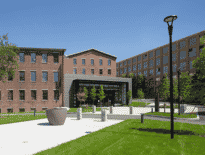Kathy Kottaridis
Executive Director, Historic Boston Inc.
Age: 56
Industry experience: 22 years
Preserving historic properties to bolster economic development in the surrounding neighborhood is central to the mission of Historic Boston Inc. The nonprofit was formed in 1960 to acquire the 1718 Old Corner Bookstore property in Downtown Crossing after a developer proposed demolishing it for a parking garage, and has completed a series of preservation projects in recent decades. Kathy Kottardis joined Historic Boston as its executive director in 2007 after leadership roles at Massachusetts Office of Small Business and Entrepreneurship and the former Boston Redevelopment Authority. HBI’s next goal: securing the designation from the city of Boston to restore and expand the former Nawn Factory in Roxbury’s Nubian Square as a holistic health center in partnership with The Wellness Collaborative of Boston.
Q: HBI recently relocated from the Eustis Street firehouse in Roxbury to the site of its original restoration project, the Old Corner Bookstore. Why was this the right time for the move?
A: In many respects at this juncture, I’d call it a little bit of swing space for us, because we learned from the initial move to Roxbury we can be just about anywhere, and we can play a lot of different roles. The reason we moved to Roxbury was: In downtown Boston, the market was strong enough they don’t need us. But there are parts of the city and projects that are difficult, and the revitalization might require us to be the tenant paying the project rent, and that’s what we did in Roxbury with the firehouse. We rehabbed that in 2011.
We were designated for that project in 2008, and conventional lending got much tougher. The tenants were not looking at that time and it made sense we would lease a space in our own building and move to Roxbury at the same time, so that we could be close to the communities we work most closely with. We also discovered Nubian Square is really a neat place to be. There’s a lot that happens there and it’s very centrally located and more connected than most people think. It’s a very accessible location.
Q: What’s the next step in the selection process for the Nawn Factory?
A: My understanding is they are just gearing up to be introducing the two proposals to the community, to bring it out to public meetings which I imagine we’ll be doing through Zoom.
The city RFP came with some grants that will be available to the successful bidder, and those have some timelines on them.
The building on the site is only one-third of the original historic building – over time, parts were lost to fire. We plan on recreating the building and the form that was there previously, effectively restoring the square-footage over three floors. And then what goes in there is a combination of education and broad-based community space, all focused on wellness activities, but also a market cafe, a revenue-generating space that would thematically be tied to Roxbury history and programming.
Q: What projects have you completed recently in neighborhood commercial districts?
A: We’ve had good luck on commercial projects in “Main Street” areas. We bought a building on Fairmount Avenue on Hyde Park and restored it for five small business spaces and four residential units above. The building dates from 1868. It’s probably not a building you’d go nuts about and say, “Save that,” but Hyde Park wasn’t founded until 1868 so it parallels the time Hyde Park began as a town. We were able to do a nice demonstration project there and we were able to recruit five new businesses.
Also we did a new marquee on the Everett Square Theater, which was in rough shape and beyond our ability to restore it as a theater. But the owner would like to do that. So, we said, “Why don’t we restore the marquee, so people know it’s there?” And in Fields Corner we partnered with a property owner with six retail spaces and one upper-story space, and we restored that from a fairly ugly corrugated metal facade to what it looked like in the 1920s. Now it’s a terrific–looking building.
A lot of people think when you’re saving a historic building, it should be where something important happened or architecture that wows you. But Boston’s historic fabric creates content and character for our daily lives that we’re sometimes unaware of unless we stop and pay attention to it. Many of these properties have been muddled up over time. By giving them some TLC and making some investments, we’re also making them more marketable and bringing them into the marketplace. It’s making them useful so they can, in fact, survive.
Q: Does COVID-19 change the strategy for ground-floor spaces?
A: You have hit the big question mark, which is unresolved. The greatest concern we have at the moment is our own new headquarters downtown building, the Old Corner Bookstore. All of the retail there suffered during the downturn, and two retailers have yet to reopen. We already had one empty space. We have resumed negotiations for that space, so that says to me that the space in downtown will pick up speed again, but the timing is the question. Chipotle is back and seems to be doing OK, and we’re just waiting to revise a few terms with the Dig Inn and Bruegger’s to get them back up and running as well. We’ve got a building in Chinatown that has one retail space and those negotiations also resumed. There’re folks who are trying to have faith that things will come back. There’s a lot of concern by retailers that there be some new protections in leases in the event there are further quarantines, which makes plenty of sense.
Q: How many projects can HBI take on at once?
A: Generally, there are at least three that are active: one in construction, one in predevelopment and one or two in the prospecting level. We’re a really small team. We’re four people, so we pretty much try to keep it around that pace. There’s a pipeline and long list of things we’re keeping our eyes on around the city, and we’re asked about things all the time. It really is a matter of where things are and whether something will move faster, depending upon available funding and level of urgency.
Kottaridis’ Five Favorite Off-the-Beaten-Path Preservation Projects
- Fowler Clark Epstein Farm (1786), Mattapan
- Clapp Family Barn (c. 1850), Dorchester
- Hayden Building (1875), Chinatown
- Dillaway Thomas House (c. 1750), Roxbury
- Roslindale Substation (1911), Roslindale Village




 |
| 


